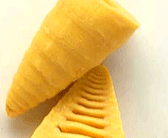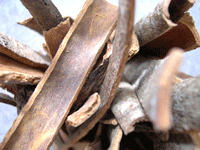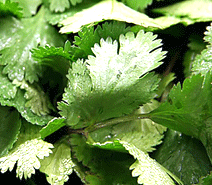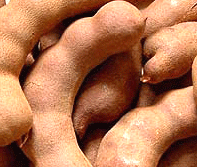Free Asian Recipes from Vietnam for Cooking Vietnamese Food
Presenting some of the most delicious recipes from Vietnam. I love Vietnamese cusine, especially eating a hot pho on a cold day and munching on a Vietnamese salad roll.
| Chicken Recipes | Beef Recipes | Seafood Recipes | Vegetarian Recipes | Dessert Recipes |
This page contains some of the most interesting and delicious recipes from Vietnam. The following are some of my favorite recipes. Main herbs to keep in mind are lemongrass, cilantro or coridander and chilli. Fish sauce is a definite must in Vietnamese cooking.
Vietnam Cuisine:
 When I close my eyes and think about Vietnam, I think about fresh salad, the smell of lemongrass, the
tartness of lime and the wonderful exotic flavor of fish sauce. Vietnamese cooking to me represent
freshness and lightness (not unlike the Japanese cuisine) that is so unique and heartfelt. Through my
friendship with Phuong, I've learnt that Vietnamese cooking doesn't have to be complex so long as you
have all the ingredients at hand.
When I close my eyes and think about Vietnam, I think about fresh salad, the smell of lemongrass, the
tartness of lime and the wonderful exotic flavor of fish sauce. Vietnamese cooking to me represent
freshness and lightness (not unlike the Japanese cuisine) that is so unique and heartfelt. Through my
friendship with Phuong, I've learnt that Vietnamese cooking doesn't have to be complex so long as you
have all the ingredients at hand.
From what I can gather from Phuong who have lived in North America for many years, she tells me that it is not surprising to find Vietnamese family gathering together and having a simple meal or rice and/or noodles at any time of the day. Rice is usually eaten together with many varities of dishes. The typical rice that Vietnam is famous for is Jasmine Rice. You can buy this type of rice from any Asian grocery store. They are a little bit pricier than normal rice but the fragrant of the rice and flavor is totally worth it.
The Red River Delta in the North and the Mekong Delta in the south are examples of two regions that produce the most rice. Currently Vietnam is the third largest exporter of rice in the world which goes to show you how important rice is to the economy. Almost 60% of land in Vietnam is given over to rice production leaving very little land for pasture and cattle farming. Therefore it is no surprise that beef is considered a luxury item. One of the most famous series of beef is the Bo Bay Mon or Beef Done in Seven Ways and as the name indicates, beef is cooked in seven ways.
Rice is not only confimed to its simple steaming but go beyond. For example, rice is also used in the production of wine adn vinegar. It is also converted into flour and used to make rice noodles, flat rice paper sheets for wrapping goi cuon (spring rolls), glutinious rice is also being cooked overnight then wrapped into attractive banana parcels tranforming into xoi or banh tay eaten during special occasions.
Vietnamese people also adore their salads. Not only are they great and refreshing but they are also great for anyone who wish to go on a diet. You can eat as much green Vietnamese salad as you like and not feel guilty about it. Examples of Vietnamese salads that you might want to try include fresh shrimp salad, chicken salad and goi chay or vegetarian salad. You can also experience salad in a roll. The Vietnamese people have probably invented the first ever salad-on-the-go where you can roll the salad into a tight roll then dipped in fish sauce or peanut sauce. There are two versions in this website, one that is not deep-fried ( Vietnamese Salad Roll) and one that is deep-fried ( Cha Gio).
Another great invention that I wanted to talk about is the Vietnamese pho or noodles soup. The typical pho soup broth is usually made from good beef stock followed by rice stick noodles and pieces of extremely thin sliced beef (usually raw) added to it. When the hot broth is poured over the noodles and beef, the beef gets cooked instantly. Every pho shop in Vietnam has a huge palte of raw herbs set on each table with an arragy of dishs from grilled to marinated beef to cha dum (pate). I love pho mixed with sweet onions, cilantro, mung bean sprouts and a decent squeeze of lemon wedge. Make a big batch of pho broth then deep freeze them in batches so you can take them out whenever you feel like it. If you're interested in making pho then try your hand at making beef noodles soup or chicken noodle soup.
I hope that you will take any of the following Vietnamese recipe (my gratitute to Phuong and all great-grandmother and her aunties) whose guidance made this Vietnamese page a reality. I hope that she will continue to write down her recipes (and share them!) for many more years to come. And I hope that you will experiment and try these recipes. Remember, they are mere guidelines so feel free to experiment and adjust to your palate.
Vietnamese Recipes
-
Index of New Vietnamese Recipes:
- Green Papaya Salad NEW
- Coconut Caramel Flan NEW
- Barbecued Five Spice Pork NEW
- Iced Coffee NEW
-
Vietnamese Sandwiches NEW
Chicken, Duck, Quail & Poultry Recipes:
- Chicken in Lemon grass & Chilli (Ga Xao Xa Ot) popular
- Chicken Salad with Herbs (Nom Ga Xe)
- Honey Roasted Chicken (Ca Quay Mat Ong)
- Stuffed Chickenwings popular
-
Vietnamese Chicken Salad
Pork, Mutton, Beef, Veal and Lamb Recipes
- Cha Gio (Vietnamese spring rolls)
- Oc Nhoi Thit (Snails Stuffed with Minced Pork)
- Beef Roll (Banh Uot Thit Nuong)
- Spicy Beef Stew (Bo Kho)
- Spicy Caramel Pork
- Pork Roll (Bi Cuon)
- Vietnamese Braised Pork
- Vietnamese 5 Spice Chicken
-
Vietnamese Spring Roll (Version II) popular
Seafood Recipes
- Asparagus and crab meat soup
- Canh Chua Dau Ca (Sour fish head soup)
- Cua Rang Muoi (Crab Fried with Salt)
- Fish Fillets with Dill and Tomato (Ca Nau Ngot)
- Fresh Shrimp Salad
- Hot and Sour Soup
- Sugarcane Shrimp (Tom Bao Mia) popular
-
Vietnamese Shrimp Cakes popular
Vegetarian Recipes
- Ca Phao Kho (Braised Eggplant)
- Canh Bi Dao (Winter Melon Soup)
-
Goi Chay (Vegetable Salad)
Noodles, Rice & Bread Recipes
- Banh Pho Bo (Beef noodle soup) popular
- Com Huong Giang (Hue rice)
- Northern Vietnamese Beef Noodle Soup
- Pho Ga (Hanoi Chicken & Rice Noodle Soup)
- Shredded Chicken Rice Porridge (Chao Ga)
- Tomato Rice (Com Sot Ca Chua )
-
Vietnamese Chicken Noodle Soup
Eggs Recipes
- Trung Trang (Egg Pancakes)
-
Canh Trung Ca Trua (Tomato and Egg Drop Soup)
Dessert & Sweets Recipes
- Banana Cake (Banh Chuoi Nuong)
- Banana cooked in coconut-sugar syrup popular
- Lemongrass Tea (Che Sa)
-
Sweet Ginger Rice (Che Con Ong)
Chicken Recipes
Beef & Pork Recipes
Seafood Recipes
Vegetarian Recipes
Dessert Recipes
 Arrowroot flour is used extensively in Vietnam for thickening sauces because it is cheaper than cornflour.
Unlike cornflour, this agent will thin after boiling.
Arrowroot flour is used extensively in Vietnam for thickening sauces because it is cheaper than cornflour.
Unlike cornflour, this agent will thin after boiling. Comes in a variety: fresh, vinegeared or dried (the most delicious). Eaten frequently in Vietnam. Fresh shoots
have a savory sweetness and crunchiness - should be peeled and boiled within 30 mins after use. Dried shoots
should be soaked then boiled. Canned bamboo shoots are also readily available.
Comes in a variety: fresh, vinegeared or dried (the most delicious). Eaten frequently in Vietnam. Fresh shoots
have a savory sweetness and crunchiness - should be peeled and boiled within 30 mins after use. Dried shoots
should be soaked then boiled. Canned bamboo shoots are also readily available. Inner petals of the flowers can be cooked or eaten raw. The leaf is usually used for wrapping
food parcels. Using banana flower is not necessary but makes for a great presentation. Use foil or
baking wax paper instead.
Inner petals of the flowers can be cooked or eaten raw. The leaf is usually used for wrapping
food parcels. Using banana flower is not necessary but makes for a great presentation. Use foil or
baking wax paper instead. Fresh mung bean sprouts taste strong with age so buy them fresh and rinse quickly before use.
Can be blanched in hot water. Remove beans and tail-end for less bitter taste.
Fresh mung bean sprouts taste strong with age so buy them fresh and rinse quickly before use.
Can be blanched in hot water. Remove beans and tail-end for less bitter taste. This rather interesting plant is a type of hard gourd that is favored for its healthful benefits. Looks
like a fat, knobby green cucumber. Has a strong bitter flavor and is often pickled in Vietnam. Before
cooking, remove the seeds and inner membrane and outer shell.
This rather interesting plant is a type of hard gourd that is favored for its healthful benefits. Looks
like a fat, knobby green cucumber. Has a strong bitter flavor and is often pickled in Vietnam. Before
cooking, remove the seeds and inner membrane and outer shell. Large oval pods, comes in brown or black seeds. Use whole to flavor soups like pho. Crush lightly
to expose the sticky black seeds, add both pods and seeds to soups and marinades. Remove pod when
grinding with other spices. Not to be confused with Chinese cardamon pods used in Indian cooking.
Large oval pods, comes in brown or black seeds. Use whole to flavor soups like pho. Crush lightly
to expose the sticky black seeds, add both pods and seeds to soups and marinades. Remove pod when
grinding with other spices. Not to be confused with Chinese cardamon pods used in Indian cooking. Fresh and pickled chillies are served at table to season dishes individually. Long, mild chillies
are most common, medium sized ones flavor dishes with more heat (used in southern and central regions)
and thiny chillies (chi thien) is the hottest. Ground chilli powder is popular in the south.
Fresh and pickled chillies are served at table to season dishes individually. Long, mild chillies
are most common, medium sized ones flavor dishes with more heat (used in southern and central regions)
and thiny chillies (chi thien) is the hottest. Ground chilli powder is popular in the south. Cinnamon and cassia bark are very similar, can be used interchanged.
It
is available ground as a powder or in tightly rolled dry sticks and/or barks.
Cinnamon and cassia bark are very similar, can be used interchanged.
It
is available ground as a powder or in tightly rolled dry sticks and/or barks.
 Strong, intense flavor, coriander is used in many recipes as well as garnish. You can grow them in pots by
removing the seeds and growing them in a well ventilated area. Herbs do not store well in fridge and should
be used within a couple days of purchasing. Store in airtight bag, making sure no moisture is trap inside.
Also available in powder form.
Strong, intense flavor, coriander is used in many recipes as well as garnish. You can grow them in pots by
removing the seeds and growing them in a well ventilated area. Herbs do not store well in fridge and should
be used within a couple days of purchasing. Store in airtight bag, making sure no moisture is trap inside.
Also available in powder form. Young coconuts (dua non) have a green husk and can be bought frozen from most Asian stores. Older
coconuts (dua gia) have a hard brown shell and is most common at Western supermarkets. Grate
firm flesh to extract milk and cream or dried dessicated. Cans are also available.
Young coconuts (dua non) have a green husk and can be bought frozen from most Asian stores. Older
coconuts (dua gia) have a hard brown shell and is most common at Western supermarkets. Grate
firm flesh to extract milk and cream or dried dessicated. Cans are also available. Small dried shrimp make a quick base for soup. Soak briefly in warm water then drained before use.
Good for stir-fries to soups. After opening, you can keep whatever that is leftover in
a sealed package and store in the freezer. Take out as needed.
Small dried shrimp make a quick base for soup. Soak briefly in warm water then drained before use.
Good for stir-fries to soups. After opening, you can keep whatever that is leftover in
a sealed package and store in the freezer. Take out as needed.  A must have in any Vietnamese and Thai kitchen, is made from fermented extract of salted small fish or sprats,
naturally brewed. Used in kitchen and as a condiment. Salty and strong flavor, use sparingly.
A must have in any Vietnamese and Thai kitchen, is made from fermented extract of salted small fish or sprats,
naturally brewed. Used in kitchen and as a condiment. Salty and strong flavor, use sparingly.  Tough green leaves or shoots, has a citronella-like color and smell. Used extensively in Vietnamese
cooking. Use bottom white part to flavor most dishes.
Tough green leaves or shoots, has a citronella-like color and smell. Used extensively in Vietnamese
cooking. Use bottom white part to flavor most dishes. Very thin and brittle sheets made from ground rice amylose and sometimes tapioca starch. Can be eaten raw
or fried but soak before use.
Very thin and brittle sheets made from ground rice amylose and sometimes tapioca starch. Can be eaten raw
or fried but soak before use. Also known as French Shallots and resemble tiny clustered onions, may be pink or purple.
Also known as French Shallots and resemble tiny clustered onions, may be pink or purple. An eight-pointed pod with aniseed flavor. When ground is a major component of a five-spice powder.
Can be used whole. Has a kind of licorish flavor and is most often used in soups.
Store in a air-tight container in a cool, dry place.
An eight-pointed pod with aniseed flavor. When ground is a major component of a five-spice powder.
Can be used whole. Has a kind of licorish flavor and is most often used in soups.
Store in a air-tight container in a cool, dry place. A star-shaped fruit, eaten unripe or fully riped. Two kinds, yellow and green (which is more sour). Delicious
and juicy, the star fruit can be a great addition to any exotic fruit salad. Delicious with gripped
or fried food.
A star-shaped fruit, eaten unripe or fully riped. Two kinds, yellow and green (which is more sour). Delicious
and juicy, the star fruit can be a great addition to any exotic fruit salad. Delicious with gripped
or fried food. Is a large, brown pod with several seeds that is rich in vitamins. Tamarind has a tangy, acidic taste and
is probably one of the most sour flavoring agent that is known in the world. It can be bought fresh,
dried or in pulp form. Most common in bulky compressed blocks (seeds removed). Paste is used in hot and sour
soups and fresh crab dishes.
Is a large, brown pod with several seeds that is rich in vitamins. Tamarind has a tangy, acidic taste and
is probably one of the most sour flavoring agent that is known in the world. It can be bought fresh,
dried or in pulp form. Most common in bulky compressed blocks (seeds removed). Paste is used in hot and sour
soups and fresh crab dishes. Fresh turmeric grows underground, can be grated then soaked. Soaking water and pulp are then used.
You should wear gloves when dealing with fresh turmeric as it will stain easily. Also available as
ground dried tumeric. Sold for medicinal purposes.
Fresh turmeric grows underground, can be grated then soaked. Soaking water and pulp are then used.
You should wear gloves when dealing with fresh turmeric as it will stain easily. Also available as
ground dried tumeric. Sold for medicinal purposes. More fiery tasting than the Western version. Sweet Thai Basil is used extensively in Vietnamese and Thai cooking.
Usually serve with bean sprouts and lime on the side of a hot steaming pho or used in salads or wraps.
More fiery tasting than the Western version. Sweet Thai Basil is used extensively in Vietnamese and Thai cooking.
Usually serve with bean sprouts and lime on the side of a hot steaming pho or used in salads or wraps.